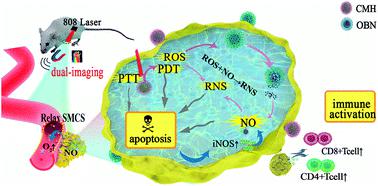当前位置:
X-MOL 学术
›
Biomater. Sci.
›
论文详情
Our official English website, www.x-mol.net, welcomes your
feedback! (Note: you will need to create a separate account there.)
A NO/ROS/RNS cascaded-releasing nano-platform for gas/PDT/PTT/immunotherapy of tumors
Biomaterials Science ( IF 5.8 ) Pub Date : 2021-06-29 , DOI: 10.1039/d1bm00726b Mengchao Ding 1 , Kai Shao , Lijuan Wu , Yuping Jiang , Bing Cheng , Lili Wang , Jinsheng Shi , Xiaoying Kong
Biomaterials Science ( IF 5.8 ) Pub Date : 2021-06-29 , DOI: 10.1039/d1bm00726b Mengchao Ding 1 , Kai Shao , Lijuan Wu , Yuping Jiang , Bing Cheng , Lili Wang , Jinsheng Shi , Xiaoying Kong
Affiliation

|
Nitric oxide (NO) gas treatment offers a promising strategy for tumor therapy; however, its practical application is still limited due to its poor efficacy and biotoxicity which were caused by gas leakage during blood delivery. Herein, a nano-platform (CMH-OBN) composed of chlorin e6-melanin-hyaluronic acid nanoparticles (Ce6-MNP-HA, CMH) and oxidized bletilla striata polysaccharide microcapsules (Oxi-BSP) carrying NO donors was prepared for responsive and cascaded release of NO, reactive oxygen species (ROS) and its secondary metabolite reactive nitrogen species (RNS) in tumor sites. Melanin not only endowed CMH with good photothermal properties, but also helped Ce6 to produce a large number of ROS under near-infrared (NIR) irradiation. OBN microcapsules, which were sensitive to ROS, can release NO donors under the stimulation of ROS released by CMH nanoparticles under NIR irradiation and can further release NO in the tumor microenvironment (TME) with high expression of glutathione (GSH). NO could further up-regulate soluble guanylate cyclase-cyclic guanosine monophosphate (sGC-cGMP) signal pathways to relieve hypoxia, thus further enhancing the photodynamic therapy (PDT). Moreover, the cascaded release of ROS and NO could produce RNS with higher lethality, which could sequentially initiate the cellular apoptotic procedure and promote immunotherapy by activating T cells at the tumor sites. More interestingly, the CMH-OBN nano-platform could supply magnetic resonance imaging (MRI) and infrared photothermal imaging guidance for tumor therapy. In conclusion, the development of a CMH-OBN nano-platform provides a satisfactory demonstration by combining NO therapy with photothermal therapy (PTT), PDT and immunotherapy for the treatment of cancer.
中文翻译:

用于气体/PDT/PTT/肿瘤免疫治疗的NO/ROS/RNS级联释放纳米平台
一氧化氮 (NO) 气体治疗为肿瘤治疗提供了一种有前景的策略;然而,由于血液输送过程中气体泄漏导致其疗效差和生物毒性,其实际应用仍然受到限制。在此,制备了由二氢卟酚 e6-黑色素 - 透明质酸纳米粒子(Ce6-MNP-HA,CMH)和携带 NO 供体的氧化白芨多糖微胶囊(Oxi-BSP)组成的纳米平台(CMH-OBN)用于响应和级联NO、活性氧 (ROS) 及其次级代谢产物活性氮 (RNS) 在肿瘤部位的释放。黑色素不仅赋予了 CMH 良好的光热性能,而且帮助 Ce6 在近红外 (NIR) 照射下产生大量 ROS。OBN 微胶囊,对 ROS 敏感,在近红外照射下CMH纳米颗粒释放的ROS刺激下,可以释放NO供体,并且可以在谷胱甘肽(GSH)高表达的肿瘤微环境(TME)中进一步释放NO。NO可以进一步上调可溶性鸟苷酸环化酶-环磷酸鸟苷(sGC-cGMP)信号通路以缓解缺氧,从而进一步增强光动力疗法(PDT)。此外,ROS和NO的级联释放可以产生具有更高致死率的RNS,这可以通过激活肿瘤部位的T细胞顺序启动细胞凋亡过程并促进免疫治疗。更有趣的是,CMH-OBN纳米平台可以为肿瘤治疗提供磁共振成像(MRI)和红外光热成像指导。综上所述,
更新日期:2021-07-16
中文翻译:

用于气体/PDT/PTT/肿瘤免疫治疗的NO/ROS/RNS级联释放纳米平台
一氧化氮 (NO) 气体治疗为肿瘤治疗提供了一种有前景的策略;然而,由于血液输送过程中气体泄漏导致其疗效差和生物毒性,其实际应用仍然受到限制。在此,制备了由二氢卟酚 e6-黑色素 - 透明质酸纳米粒子(Ce6-MNP-HA,CMH)和携带 NO 供体的氧化白芨多糖微胶囊(Oxi-BSP)组成的纳米平台(CMH-OBN)用于响应和级联NO、活性氧 (ROS) 及其次级代谢产物活性氮 (RNS) 在肿瘤部位的释放。黑色素不仅赋予了 CMH 良好的光热性能,而且帮助 Ce6 在近红外 (NIR) 照射下产生大量 ROS。OBN 微胶囊,对 ROS 敏感,在近红外照射下CMH纳米颗粒释放的ROS刺激下,可以释放NO供体,并且可以在谷胱甘肽(GSH)高表达的肿瘤微环境(TME)中进一步释放NO。NO可以进一步上调可溶性鸟苷酸环化酶-环磷酸鸟苷(sGC-cGMP)信号通路以缓解缺氧,从而进一步增强光动力疗法(PDT)。此外,ROS和NO的级联释放可以产生具有更高致死率的RNS,这可以通过激活肿瘤部位的T细胞顺序启动细胞凋亡过程并促进免疫治疗。更有趣的是,CMH-OBN纳米平台可以为肿瘤治疗提供磁共振成像(MRI)和红外光热成像指导。综上所述,


















































 京公网安备 11010802027423号
京公网安备 11010802027423号